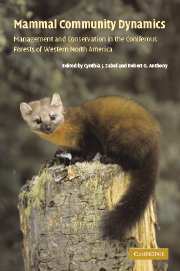 Mammal Community Dynamics
Mammal Community Dynamics Book contents
- Frontmatter
- Contents
- List of contributors
- Foreword
- Acknowledgments
- Part I Management and conservation issues for various taxa
- 1 Introduction and historical perspective
- 2 Forests and woodlands of western North America
- 3 Faunal composition and distribution of mammals in western coniferous forests
- 4 Habitat ecology and conservation of bats in western coniferous forests
- 5 Ecological relationships of terrestrial small mammals in western coniferous forests
- 6 Ecology and conservation of arboreal rodents of western coniferous forests
- 7 Small and mid-sized carnivores
- 8 Ecology, conservation, and restoration of large carnivores in western North America
- 9 Ungulates in western coniferous forests: habitat relationships, population dynamics, and ecosystem processes
- Part II Community and ecosystem relations
- Part III Conservation issues and strategies
- Index
- References
4 - Habitat ecology and conservation of bats in western coniferous forests
Published online by Cambridge University Press: 15 December 2009
- Frontmatter
- Contents
- List of contributors
- Foreword
- Acknowledgments
- Part I Management and conservation issues for various taxa
- 1 Introduction and historical perspective
- 2 Forests and woodlands of western North America
- 3 Faunal composition and distribution of mammals in western coniferous forests
- 4 Habitat ecology and conservation of bats in western coniferous forests
- 5 Ecological relationships of terrestrial small mammals in western coniferous forests
- 6 Ecology and conservation of arboreal rodents of western coniferous forests
- 7 Small and mid-sized carnivores
- 8 Ecology, conservation, and restoration of large carnivores in western North America
- 9 Ungulates in western coniferous forests: habitat relationships, population dynamics, and ecosystem processes
- Part II Community and ecosystem relations
- Part III Conservation issues and strategies
- Index
- References
Summary
Introduction
Until recently, little was known about most aspects of the ecology of bats in forests. A basic understanding of several fundamental elements of the natural history of forest-dwelling bats, such as characteristics of habitat used for foraging and structures used for roosting, was lacking or minimal. In addition, influences of forest structure and management practices on bats were almost entirely unknown. Within the past decade, significant strides have been made in the development of our understanding of the ecology of bats in western coniferous forests and the influences of forest management on bats, but substantial gaps in the knowledge base remain. In this chapter, I review what is known about the habitat ecology of bats in western coniferous forests, evaluate the strengths and weaknesses of the current state of knowledge, suggest directions for future research, and discuss some of the implications for forest management and conservation of bats. I emphasize information based on studies conducted within western coniferous forests whenever possible. Throughout my review, I generally focus on aspects of the ecology of bats in western coniferous forests that are common to several species. Although emphasizing commonalities among species is valuable to help identify unifying principles, it should be recognized that each species has a unique natural history and suite of behavioral characteristics, and that these differences are often important in the conservation of bats.
Forty species of bats occur west of the Mississippi River and north of Mexico.
- Type
- Chapter
- Information
- Mammal Community DynamicsManagement and Conservation in the Coniferous Forests of Western North America, pp. 81 - 119Publisher: Cambridge University PressPrint publication year: 2003
References
- 22
- Cited by


